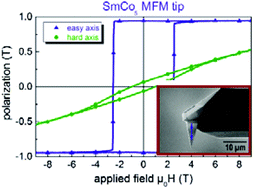Epitaxial hard magnetic SmCo5 MFM tips – a new approach to advanced magnetic force microscopy imaging†
Abstract
Cantilever based scanning force sensors, which probe a specific tip–sample interaction through a functional tip coating, are limited by the material performance achievable in the coating process. In case of the wide spread magnetic force microscopy (MFM) technique, the magnetic performance of MFM tips, especially the response to magnetic fields and the coercivity, fall far behind the quality known from permanent magnet films prepared with optimized process conditions on appropriate substrates. We resolve this limitation by starting from an optimized thin film architecture – a highly anisotropic SmCo5 film grown epitaxially on MgO(110) substrates – from which a tip is separated by focused ion beam and is attached to a cantilever. Not compromising on resolution and sensitivity, we demonstrate an unrivaled rigidity in magnetic fields, which will largely advance quantitative microscopic investigation of magnetic materials with strong stray fields and allows MFM measurements in external magnetic fields of currently up to 0.7 T. The material optimization for a specific sample – cantilever interaction without restrictions in substrate, film architecture, film preparation conditions and tip shape, is not limited to MFM but offers new opportunities also for other scanning force microscopy modes.



 Please wait while we load your content...
Please wait while we load your content...